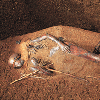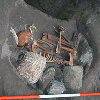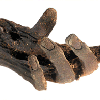
True tales from the peat marshes of northern Europe
![[image]](images/bogbodies2.gif)
Lindow Man (Courtesy the Trustees of the British Museum)
Aside from a bit of periodontal disease, he was a healthy man in his 30s, about 5'7" tall, with a strong build. He had recently eaten porridge made from barley, grass, wheat, and herbs, and maybe a few bites of pork. But the meal was his last. Between 12 and 24 hours after dinner, he was strangled. His throat was slashed from ear to ear, and his body was thrown into a Danish peat bog. He lay in this grave until 1952, when residents of the nearby village of Grauballe were cutting peat for fuel and found his remains. He still had his skin and a full head of hair. Soon he became known as Grauballe Man and although it looks like he died recently, he lived almost 2,300 years ago.
Thirty-two years later in a bog called Lindow Moss in northwest England, peat cutters saw what they thought was a piece of wood that might jam the shredding machinery. But when they removed it and the peat coating fell off, it turned out to be a human foot. Police were already investigating the area as a possible crime scene because a year earlier a human head, thought to have belonged to a woman who had disappeared under suspicious circumstances in 1960, had turned up at the site. The woman's husband quickly confessed to her murder, despite the fact that the skull was eventually found to belong to a man who lived more than 2,000 years ago. County archaeologist Rick Turner negotiated with the police and took the peat where the foot had been found to a local lab. Soon the head, arms, and torso of "Lindow Man" emerged.
Lindow Man lived in the first century A.D., and was a healthy person in his 20s. He had just had a haircut, and his well-manicured nails and smooth hands suggested he hadn't done much physical labor during his life. He had also recently eaten a meal—a grilled bran pancake that had burned while it was cooking—which he washed down with a drink made from mistletoe. Shortly thereafter he suffered two blows to the head, one of which drove a bone splinter into his brain. He was strangled with a garrotte made of animal sinew that was still on his neck, two cervical vertebrae were broken, his neck was slashed across his jugular vein, and one of his ribs was broken, possibly from a knee pressing against his back. And then he, too, was thrown into a bog.
For more then 10,000 years, peat bogs, mostly in northwestern Europe, have been the final resting place for hundreds, maybe thousands, of bodies. The first reports of their discovery appeared in the 18th century, and they have been found, usually by peat cutters, ever since. There are very old bog bodies—the earliest is the Koelbjerg Woman from Denmark, dated to about 8000 B.C.—medieval bog bodies, and even the remains of Soviet fighter pilot Boris Lazarev, who was shot down over northern Russia in 1943. Only about 20 are as complete as Grauballe Man and Lindow Man; others are just bones or body parts. Many were hastily removed, some improperly conserved or forgotten in museum storage. One was sold at a London auction, and some were even ground up into "mummy powder" and marketed as medication.
![[image]](images/bogbodies1.gif)
Grauballe Man (Robert Clark)
But many of the most remarkable examples still exist (and a few new ones have surfaced) and continue to fascinate. Their names are perhaps unfamiliar and—with the exception of "Pete Marsh," Lindow Man's nickname—not particularly memorable. But the desire to name them at all, even if only by their location, speaks to the strong connection to the past that bog bodies create. "Bog bodies are special because they have flesh. They look like us," says Jody Joy, the British Museum curator who is responsible for the care of Lindow Man's remains. Techniques like facial reconstruction animate Yde Girl, a 16-year-old found in the Netherlands more than a century ago, and X-rays and CT scans enable us to look under Grauballe Man's skin, into his stomach, and to document every inch of him.
But for all we think we know about these ancient people, how well do we really understand them? "Bog bodies" is a term commonly used to classify the hundreds of human remains from northwestern Europe that date to the Iron Age (ca. 500 B.C.ľA.D. 100). For the Celtic tribes that lived during this period, bogs were sacred settings for religious rituals, including dedications, offerings, and sacrifices. Most bog bodies have been interpreted in an almost uniform, and often sensationalist, way. Either they were criminals, social deviants, or human sacrifices who were tortured. Twentieth-century scholars have also tended to see them as a pan-European phenomenon of Celtic religious practices. But Wijnand van der Sanden, head archaeologist for the province of Drenthe in the Netherlands, where Yde Girl was found, believes they have been taken out of their contexts. "Bog bodies are not equal in each and every respect," says van der Sanden. "We must now begin to study exactly where they were thrown in the bog and put them in geographical perspective." But this approach is only beginning to catch on.
New discoveries of bog bodies are rare; the heavy machinery used by commercial peat cutters can dismember and destroy them. Over the past century, bogs have been disappearing because of excessive harvesting of peat, and those still left in Denmark and Holland are now protected. Consequently, much of the current research focuses on reexamining the dates, nutrition, and deaths of the bog bodies found over the last century, as well as their relationships to their environments. Scholars are also working to correct previous errors resulting from a tendency to sensationalize. Many injuries previously ascribed to torture or particularly violent means of execution were likely caused by more natural means. Grauballe Man's leg and skull were broken by the weight of the peat over millennia, not as part of his execution. And the fact that some bog bodies are naked can be attributed to the disintegration of their linen clothing after thousands of years in a wet, acidic environment, not some aspect of the ritual surrounding their death.
We may never know definitively whether any individual was a priest or a criminal, honored or punished, executed or sacrificed. "But bog bodies are not just archaeological finds," says University of Copenhagen scholar and bog body expert Niels Lynnerup. "They are extraordinarily intact human remains, and deserve to be treated as such." The people on the next pages may appear gruesome, even horrifying. But they all have stories—some innocent and some macabre—written in their uncannily preserved remains.
 Tollund Man |
 Windeby Girl and Weerdinge Couple |
 Cladh Hallan |
 Red Franz |
 The Girl of Uchter Moor |
 Clonycavan and Old Croghan Men |

Why should a place so damp and fetid—nearly a swamp—preserve anything? It has to do with how inhospitable the conditions in a bog are for the bacteria that usually do the business of decomposition. Read more... |

Human bodies aren't the only residents of northern European bogs. Cold, wet, anoxic, acidic peat also preserves metal, wood, clothing, and leather, among other things. Read more... |
Jarrett A. Lobell is executive editor and Samir S. Patel is senior editor at ARCHAEOLOGY.
- See more articles on bog bodies.
Advertisement

Advertisement







